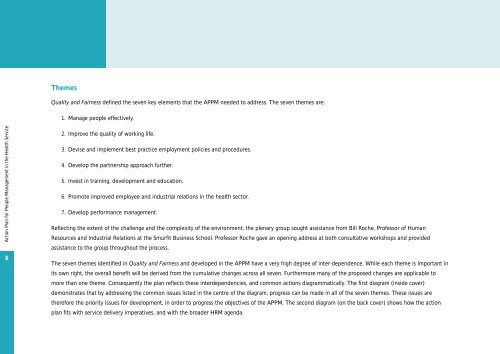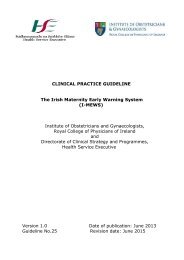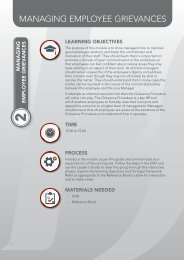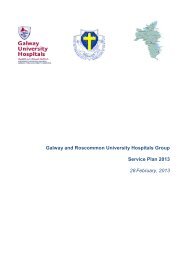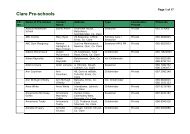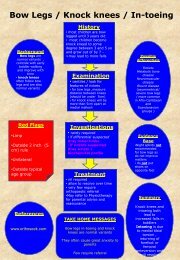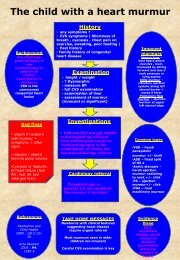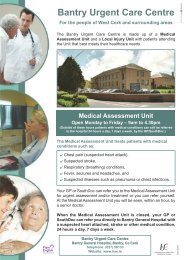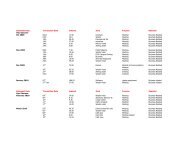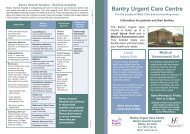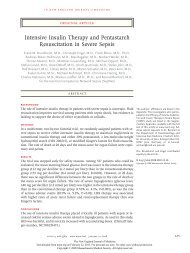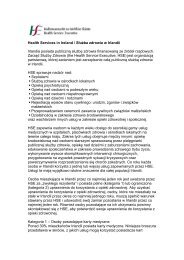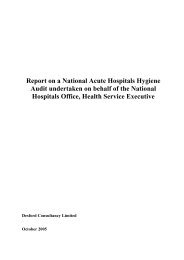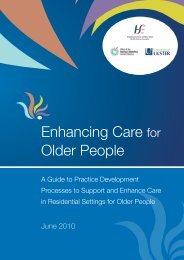Action Plan for People Management in the Health Service
Action Plan for People Management in the Health Service
Action Plan for People Management in the Health Service
You also want an ePaper? Increase the reach of your titles
YUMPU automatically turns print PDFs into web optimized ePapers that Google loves.
<strong>Action</strong> <strong>Plan</strong> <strong>for</strong> <strong>People</strong> <strong>Management</strong> <strong>in</strong> <strong>the</strong> <strong>Health</strong> <strong>Service</strong><br />
6<br />
Themes<br />
Quality and Fairness def<strong>in</strong>ed <strong>the</strong> seven key elements that <strong>the</strong> APPM needed to address. The seven <strong>the</strong>mes are:<br />
1. Manage people effectively.<br />
2. Improve <strong>the</strong> quality of work<strong>in</strong>g life.<br />
3. Devise and implement best practice employment policies and procedures.<br />
4. Develop <strong>the</strong> partnership approach fur<strong>the</strong>r.<br />
5. Invest <strong>in</strong> tra<strong>in</strong><strong>in</strong>g, development and education.<br />
6. Promote improved employee and <strong>in</strong>dustrial relations <strong>in</strong> <strong>the</strong> health sector.<br />
7. Develop per<strong>for</strong>mance management.<br />
Reflect<strong>in</strong>g <strong>the</strong> extent of <strong>the</strong> challenge and <strong>the</strong> complexity of <strong>the</strong> environment, <strong>the</strong> plenary group sought assistance from Bill Roche, Professor of Human<br />
Resources and Industrial Relations at <strong>the</strong> Smurfit Bus<strong>in</strong>ess School. Professor Roche gave an open<strong>in</strong>g address at both consultative workshops and provided<br />
assistance to <strong>the</strong> group throughout <strong>the</strong> process.<br />
The seven <strong>the</strong>mes identified <strong>in</strong> Quality and Fairness and developed <strong>in</strong> <strong>the</strong> APPM have a very high degree of <strong>in</strong>ter-dependence. While each <strong>the</strong>me is important <strong>in</strong><br />
its own right, <strong>the</strong> overall benefit will be derived from <strong>the</strong> cumulative changes across all seven. Fur<strong>the</strong>rmore many of <strong>the</strong> proposed changes are applicable to<br />
more than one <strong>the</strong>me. Consequently <strong>the</strong> plan reflects <strong>the</strong>se <strong>in</strong>terdependencies, and common actions diagrammatically. The first diagram (<strong>in</strong>side cover)<br />
demonstrates that by address<strong>in</strong>g <strong>the</strong> common issues listed <strong>in</strong> <strong>the</strong> centre of <strong>the</strong> diagram, progress can be made <strong>in</strong> all of <strong>the</strong> seven <strong>the</strong>mes. These issues are<br />
<strong>the</strong>re<strong>for</strong>e <strong>the</strong> priority issues <strong>for</strong> development, <strong>in</strong> order to progress <strong>the</strong> objectives of <strong>the</strong> APPM. The second diagram (on <strong>the</strong> back cover) shows how <strong>the</strong> action<br />
plan fits with service delivery imperatives, and with <strong>the</strong> broader HRM agenda.


